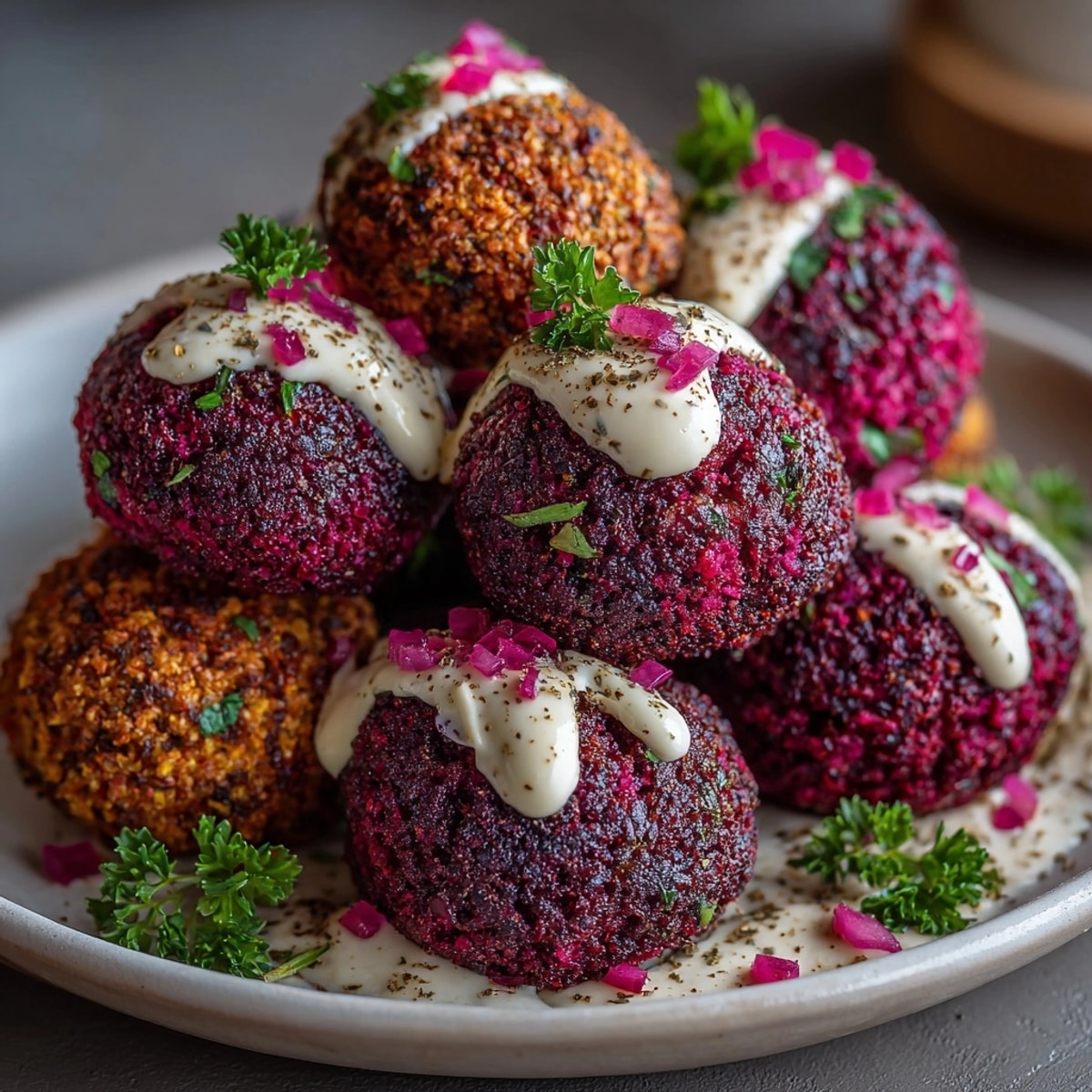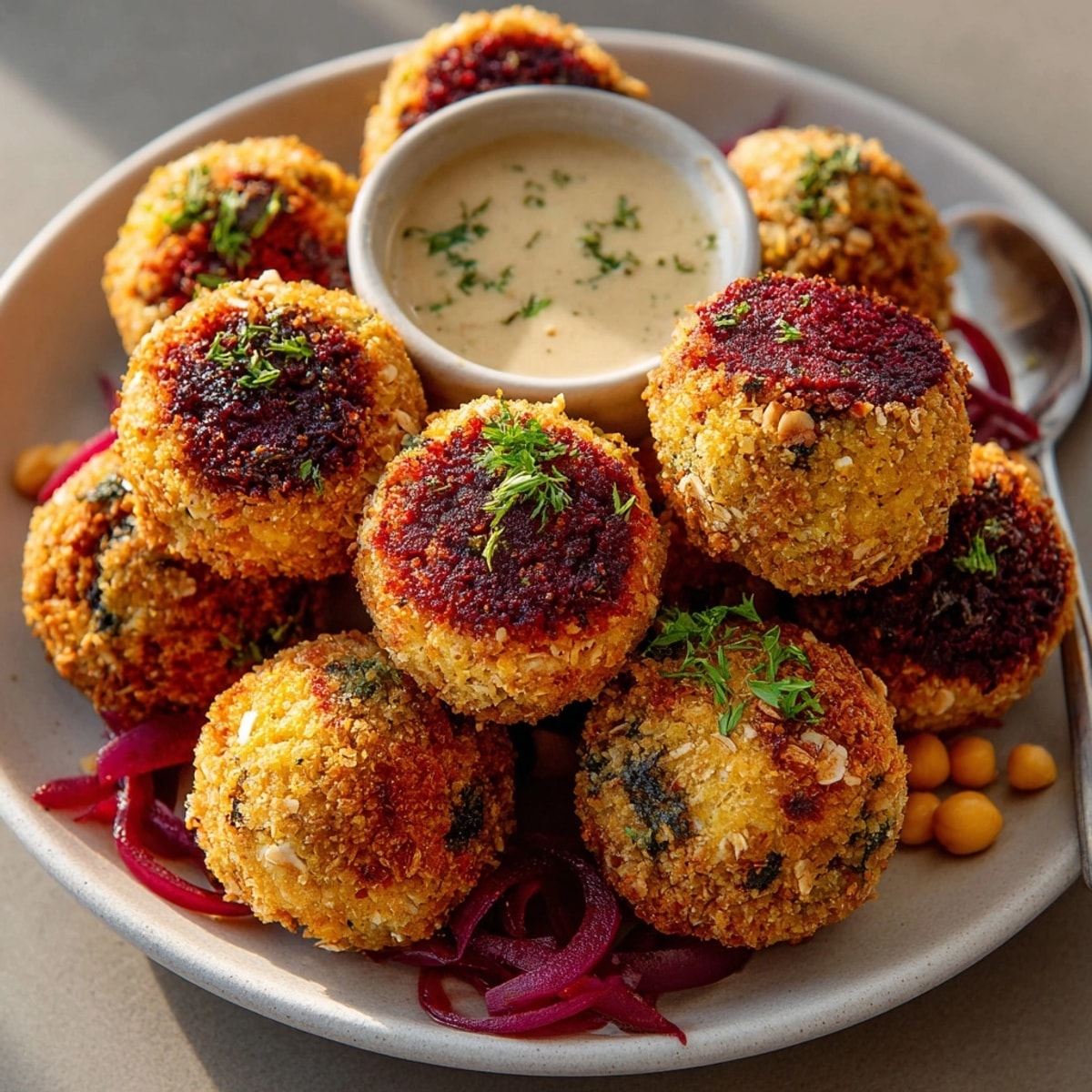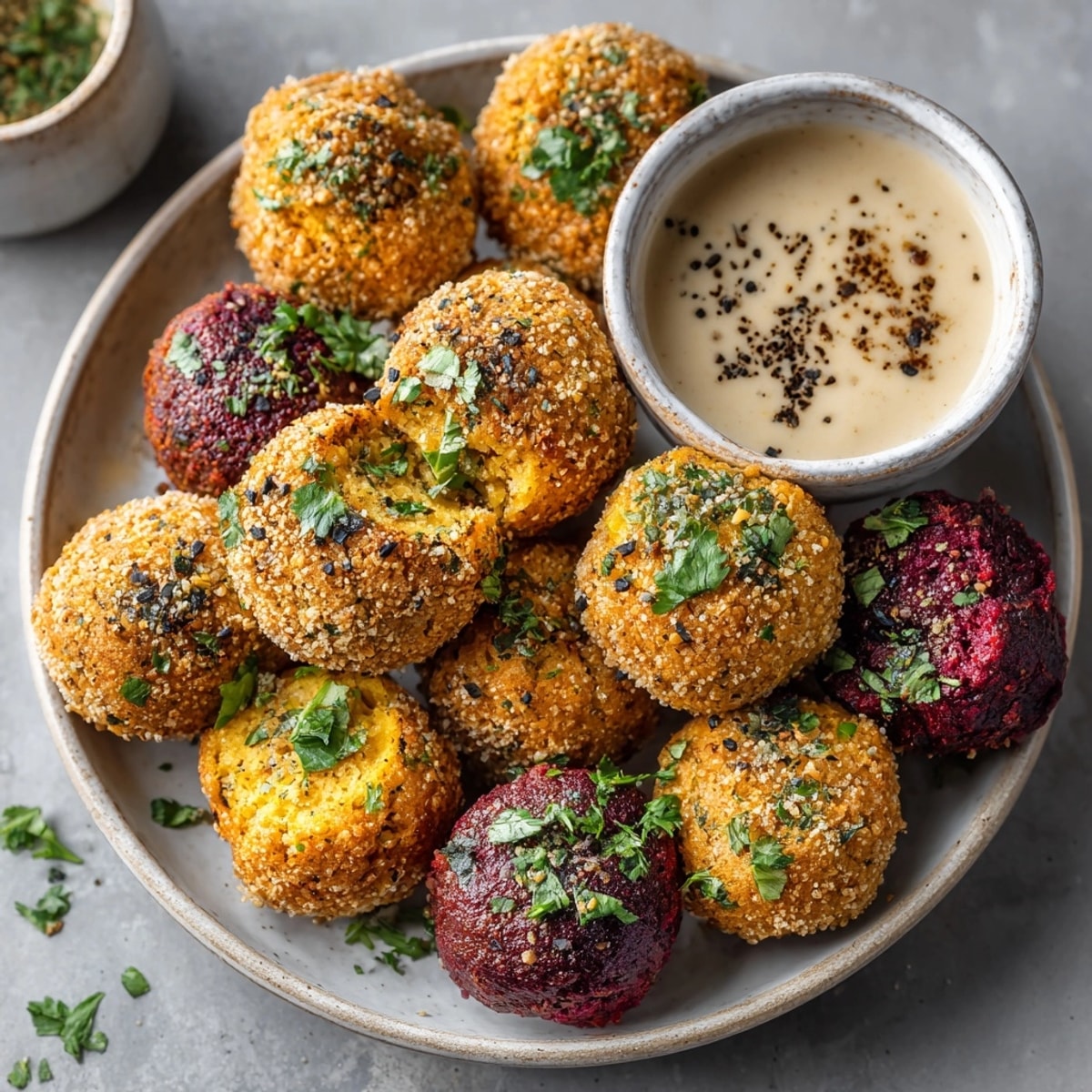 Save
Save This hearty beet falafel recipe transforms ordinary chickpea balls into vibrant pink masterpieces that will wow your guests and satisfy your craving for something both healthy and indulgent. The earthy sweetness of beets pairs perfectly with traditional falafel spices for a modern twist on a Middle Eastern classic.
I first created these when trying to use up some leftover roasted beets and my family was immediately obsessed. My daughter now calls them pink power balls and requests them weekly in her lunch box.
Ingredients
- Cooked beetroot: provides that gorgeous color and earthy sweetness. Choose firm beets with smooth skin for the best flavor.
- Cooked chickpeas: create the traditional falafel base. Canned works perfectly but home cooked gives a slightly better texture.
- Red onion: adds sharpness that balances the sweetness of the beets. Look for firm onions with tight dry skins.
- Fresh garlic cloves: bring essential aromatic flavor. Always use fresh not jarred for the best taste.
- Fresh herbs parsley and cilantro: provide brightness and traditional flavor. Use the stems too for extra flavor.
- Chickpea flour: helps bind everything together while keeping the recipe gluten free. It also adds protein and authentic flavor.
- Rolled oats: provide texture and help absorb moisture. Quick cooking or old fashioned both work well.
- Baking powder: creates a lighter texture inside the falafel. Check that its fresh for best results.
- Ground spices cumin coriander paprika and black pepper: create the signature falafel flavor profile. Toast them briefly before adding for enhanced flavor.
- Sea salt: enhances all the flavors. Use fine sea salt for even distribution.
Instructions
- Prepare the Base:
- Add beetroot chickpeas onion garlic and fresh herbs to your food processor. Pulse carefully about 8 to 10 times until everything is finely chopped but still has texture. You want small visible pieces not a smooth puree. Stop and scrape down the sides of the processor bowl at least once during this process to ensure even chopping.
- Add Dry Ingredients:
- Add all the dry ingredients including the chickpea flour oats baking powder and all spices to the food processor. Pulse another 5 to 7 times until everything is well combined but still maintains some texture. The mixture should hold together when pressed between your fingers but still have visible bits of ingredients throughout. If it seems too wet add a bit more chickpea flour one tablespoon at a time.
- Rest the Mixture:
- Transfer the mixture to a bowl cover with plastic wrap or a clean kitchen towel and refrigerate for at least 20 minutes. This resting time is crucial as it allows the flour and oats to absorb moisture making the mixture easier to shape and helping the falafel hold together during cooking. You can leave it in the refrigerator for up to 24 hours if you want to prepare ahead.
- Form the Falafel:
- With slightly damp hands to prevent sticking take about 2 tablespoons of mixture and gently roll between your palms to form balls approximately 1.5 inches in diameter. Place formed balls on a plate or baking sheet. You should get 16 to 18 falafels from this recipe. If the mixture feels too sticky dampen your hands more frequently while shaping.
- Cook the Falafel:
- For frying heat 1 inch of vegetable oil in a deep heavy bottomed skillet to 350°F. Working in batches of 4 to 5 balls at a time carefully lower the falafel into the hot oil using a slotted spoon. Fry for 3 to 4 minutes turning occasionally until deeply golden and crisp on all sides. Transfer to paper towels to drain excess oil. For baking preheat your oven to 400°F and line a baking sheet with parchment paper. Place the falafel balls on the sheet spray or brush lightly with olive oil and bake for 20 to 25 minutes turning halfway through until firm and crisp on the outside.
- Serve Immediately:
- Serve the falafel hot with tahini sauce hummus in pita bread or atop a fresh salad. The contrast between the crispy exterior and tender pink interior is best enjoyed right after cooking.
 Save
Save The beets are truly the star ingredient here. I discovered this combination when I had an abundance of beets from my garden one summer. My initial attempts were too moist until I discovered that a brief rest in the refrigerator makes all the difference in the texture. Now my family requests these vibrant falafels for special occasions and casual weeknight dinners alike.
Storage and Make Ahead Tips
These beet falafels stay fresh in an airtight container in the refrigerator for up to 4 days. To reheat place them in a 350°F oven for 10 minutes until warmed through and crisp again. The microwave works in a pinch but sacrifices the crispy exterior. For meal prep I often double the recipe and freeze half. Shape the balls then freeze them on a baking sheet before transferring to a freezer bag. They can be cooked directly from frozen just add about 5 minutes to the cooking time. This is perfect for those busy weeknights when you need a quick protein option. The uncooked mixture itself can be stored in the refrigerator for up to 2 days before shaping and cooking allowing you to break up the preparation steps if needed.
Creative Serving Suggestions
Transform these vibrant falafels into a complete meal with these serving ideas Create a Mediterranean bowl with quinoa cucumber tomato salad pickled red onions and tahini drizzle Stuff them into warm pita pockets with shredded lettuce yogurt sauce and pickled vegetables Serve as an appetizer with a side of beet hummus for a color coordinated presentation Crumble over a green salad for a protein packed lunch option Make sliders using small buns topped with arugula and garlic aioli
The bright pink color makes these particularly appealing for children and creates a stunning presentation for dinner parties.
Troubleshooting Tips
If your falafel mixture seems too wet and wont hold shape add more chickpea flour one tablespoon at a time until it reaches the right consistency. Conversely if its too dry add a teaspoon of olive oil or water. For the crispiest exterior make sure your oil is properly heated before frying. Test by dropping a small piece of mixture in the oil it should sizzle immediately but not smoke. If baking spray or brush with oil generously to help achieve a crispy exterior similar to frying. Convection settings can enhance crispiness even further. Let the mixture rest sufficiently in the refrigerator. This step is crucial for the ingredients to bind together properly and prevent the falafel from falling apart during cooking.
 Save
Save Seasonal Adaptations
Spring try adding fresh mint and a touch of lemon zest for brightness Summer incorporate grated zucchini reducing beetroot slightly to maintain moisture balance Fall mix in roasted butternut squash with the beets for additional sweetness Winter add warming spices like cinnamon and allspice for a cozy flavor profile
These adaptations keep the recipe exciting throughout the year while taking advantage of seasonal produce availability. The basic technique remains the same regardless of the variation you choose.
These beet falafels are a versatile and vibrant addition to any meal. Enjoy them as a healthy snack appetizer or main course.
Recipe Questions
- → What gives these falafel balls their vibrant color?
The beetroot provides a rich, deep pink hue, making the falafel visually striking and extra nutritious.
- → Can I bake instead of fry for a lighter option?
Yes, baking at 400°F with a spray of olive oil creates a crispy exterior with less fat than frying.
- → What sauces pair best with these falafel balls?
Classic choices include tahini sauce, lemony hummus, or a garlicky vegan yogurt drizzle.
- → Is this dish gluten-free?
Use certified gluten-free flour and oats for a gluten-free version. Always check ingredient labels to confirm.
- → How can I ensure my falafel mixture holds together?
Refrigerate the mixture for firmness, and pulse just enough to keep some texture while binding the ingredients.